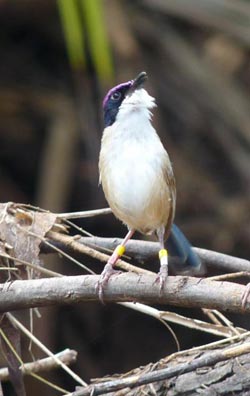Low-pitched song indicates fairy-wren size

Male purple-crowned fairy-wrens sing trill songs in response to predator calls. They seem to take advantage of the attention attracted by predator calls, and sing their advertising songs when females are paying most attention. <br><br>Credit: Michelle L Hall<br>
The study led by University of Melbourne researcher Dr Michelle Hall, is the first to show that the larger the male fairy wren, the lower the pitch of his song.
“This is the first time we have been able to show that song pitch indicates body size in song birds,” said Dr Hall from the University's Department of Zoology.
The study, which began when Dr Hall was at the Max Planck Institute for Ornithology in Germany, has been published today in the journal PLOS ONE.
Reliable communication about body size between animals is particularly important when communicating with mates or rivals. For example the bigger the rival is, the more likely it is to win in a fight so a song pitch indicating a large size may deter rivals.
“Surprisingly, there is very little evidence that the pitch of calls indicates body size differences within species, except in frogs,” she said.
“In birds in particular, there has been no evidence that the pitch of songs indicated the size of the singer until now.”
The study involved measuring the leg length (a good indicator of overall body size) of 45 adult male purple-crowned fairy-wrens. It found there was a correlation between the lowest song pitches and male size.
“We found the bigger males sang certain song types at a lower pitch than smaller males,” she said.
Purple-crowned fairy-wrens are creek-dwelling birds from northern Australia and, like their close relatives the blue wrens, males sing trill songs after the calls of certain predators, a context that seems to attract the attention of females.
Males have a repertoire of trill song variants, and it is the low-pitched variants that indicate the size of the singer.
Dr Hall showed that it may be the complexity of birdsong that has obscured the relationship between body size and song frequency in the past.
“Birds can have large repertoires of song types spanning a wide frequency range, and some birds even shift the pitch of their songs down in aggressive contexts,” she said.
“Focusing on the lowest pitches that males were able to sing was the key to finding the correlation with body size.”
The study was conducted at Mornington Wildlife Sanctuary in collaboration with Dr Anne Peters (Monash University) and Dr Sjouke Kingma (University of East Anglia, UK), and funded by the German Max Planck Institute for Ornithology.
Media Contact
More Information:
http://www.unimelb.edu.auAll latest news from the category: Life Sciences and Chemistry
Articles and reports from the Life Sciences and chemistry area deal with applied and basic research into modern biology, chemistry and human medicine.
Valuable information can be found on a range of life sciences fields including bacteriology, biochemistry, bionics, bioinformatics, biophysics, biotechnology, genetics, geobotany, human biology, marine biology, microbiology, molecular biology, cellular biology, zoology, bioinorganic chemistry, microchemistry and environmental chemistry.
Newest articles

Bringing bio-inspired robots to life
Nebraska researcher Eric Markvicka gets NSF CAREER Award to pursue manufacture of novel materials for soft robotics and stretchable electronics. Engineers are increasingly eager to develop robots that mimic the…

Bella moths use poison to attract mates
Scientists are closer to finding out how. Pyrrolizidine alkaloids are as bitter and toxic as they are hard to pronounce. They’re produced by several different types of plants and are…

AI tool creates ‘synthetic’ images of cells
…for enhanced microscopy analysis. Observing individual cells through microscopes can reveal a range of important cell biological phenomena that frequently play a role in human diseases, but the process of…





















